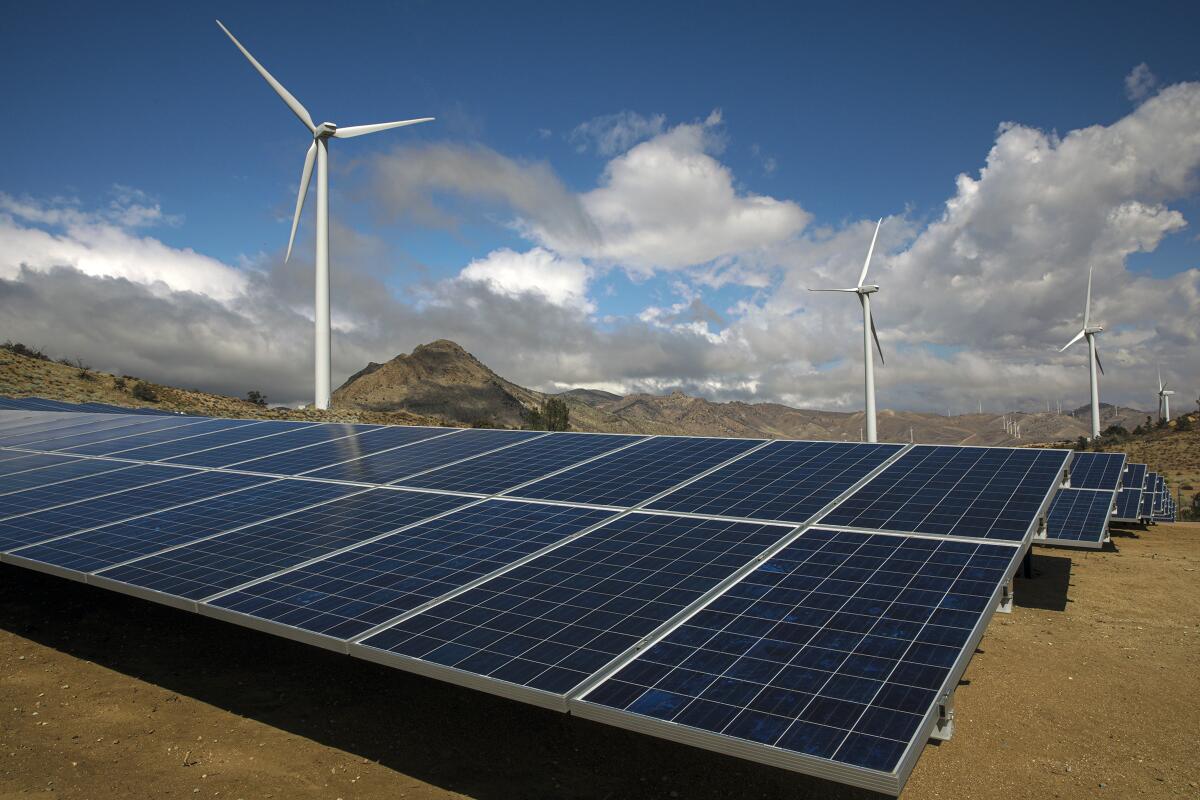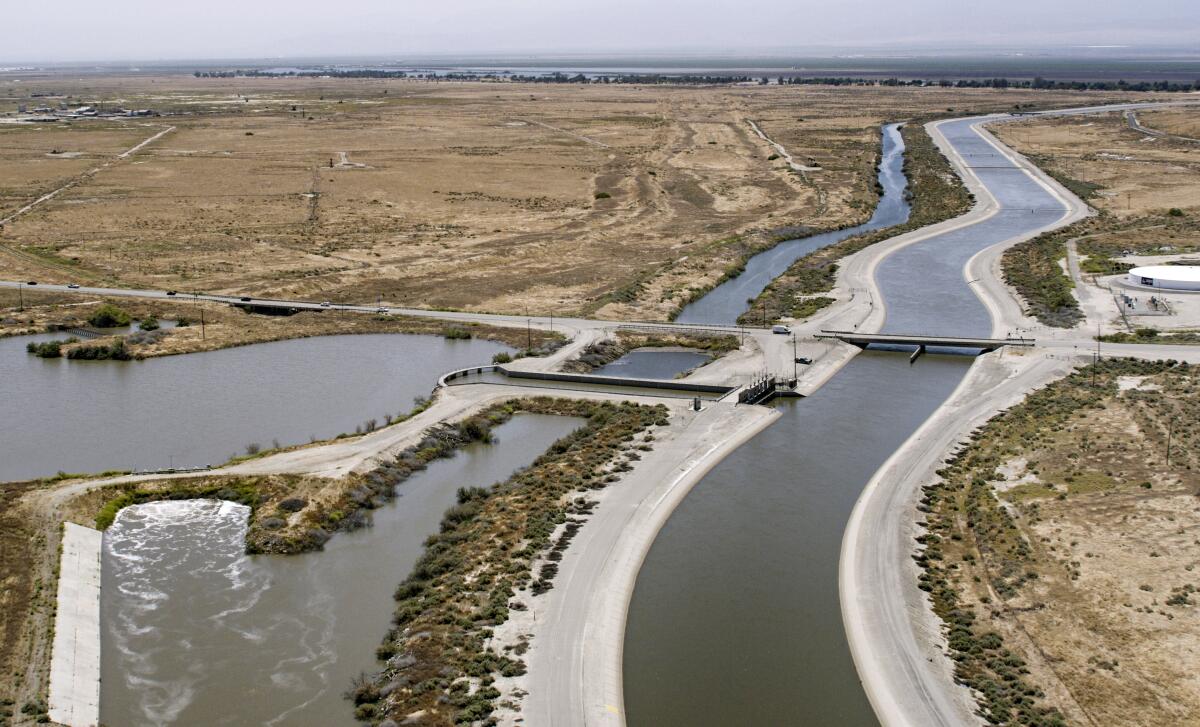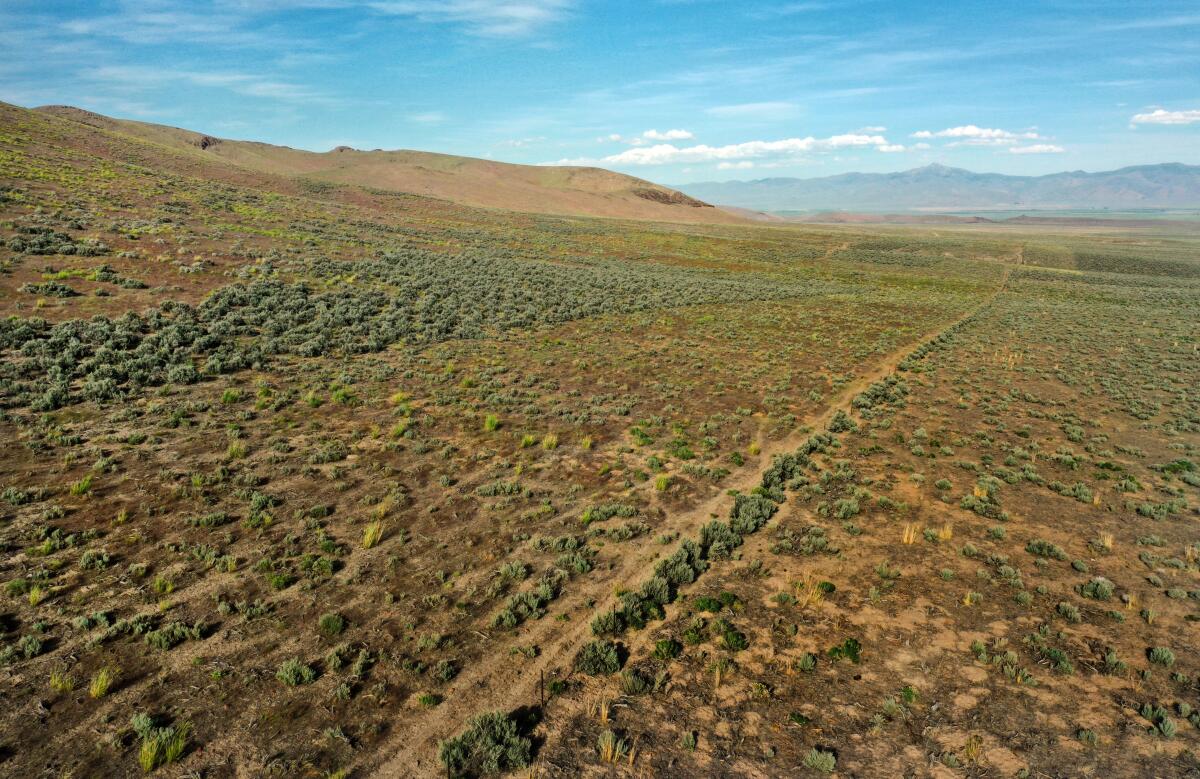Column: Extreme heat is deadly. Californians need to pay up to protect themselves

- Share via
“If there is one idea in this book that might save your life, it is this: The human body, like all living things, is a heat machine. Just being alive generates heat. But if your body gets too hot too fast — it doesn’t matter if the heat comes from the outside on a hot day or the inside from a raging fever — you are in big trouble.”
So writes journalist Jeff Goodell in “The Heat Will Kill You First,” an eye-opening, blood-curdling investigation into the many ways that rising temperatures from fossil fuel combustion are making our planet increasingly unlivable. Jeff is one of several authors I’ll be interviewing next month at the L.A. Times Festival of Books, as part of a climate change panel taking place the afternoon of Saturday, April 20. If you live in the Los Angeles area or will be in town, I hope you can be there.
Jeff’s book was on my mind last week as I read this story by my L.A. Times colleague Hayley Smith, who reported that California officials voted to approve the state’s first-ever heat illness prevention standards for indoor workers — despite last-minute objections from the state Department of Finance, which raised concerns that the rules could cost prisons and other state entities billions of dollars.
Really? Life-saving heat rules and you’re worried they’re going to be too expensive?
You're reading Boiling Point
Sammy Roth gets you up to speed on climate change, energy and the environment. Sign up to get it in your inbox twice a week.
You may occasionally receive promotional content from the Los Angeles Times.
Look, I get that it’s the Department of Finance’s job to look out for the taxpayer. I pay taxes. I want my money spent wisely.
But as Jeff writes in his book, we need to be a lot more cognizant of the costs of heat. He cites a Dartmouth College study estimating that since the 1990s, heat waves worsened by the climate crisis have cost the global economy $16 trillion.
“Heat lowers children’s test scores and raises the risk of miscarriage in pregnant women,” he writes. “Prolonged exposure increases death rates from heat and kidney disease. When people are stressed by heat, they are more impulsive and prone to conflict. Racial slurs and hate speech in social media spike. Suicides rise. Gun violence increases. There are more rapes and more violent crime. In Africa and the Middle East, studies have found a link between higher temperatures and the outbreak of civil war.”
So as if direct heat deaths weren’t bad enough, high temperatures can have other consequences.
And direct heat deaths are bad enough, by the way.
Jeff points to an estimate that nearly half a million people die each year globally from extreme heat — twice the number of people who die from firearms. He also points out that a single European heat wave in 2003, when global warming wasn’t nearly as bad as it is now, killed at least 70,000 people — more than the number of U.S. personnel killed during the entire Vietnam War.
So forgive me if I’m not super sympathetic when a spokesperson for the California finance department says officials were unable to do “fiscal due diligence” because they didn’t get some data related to the heat regulations until February.
I’m not just griping for the sake of griping: The finance department might be able to block the heat rules from going into effect. Even though the board of the California Division of Occupational Safety and Health voted unanimously to approve the rules, the finance folks say the state’s Office of Administrative Law needs their approval before it can actually implement them.
I’ll be watching to see what Hayley and the rest of our journalists report next.
And of course there are equity concerns. California’s lowest-income residents — already squeezed by absurd housing costs, rising energy bills and slowing but still high inflation — shouldn’t be stuck paying through the roof for heat protections, especially when the wealthiest individuals and corporations have spewed the vast majority of heat-trapping gases into the atmosphere.
But equity works both ways. It’s society’s most vulnerable members — the poor who can’t afford to run their air conditioners, the elderly with medical conditions and no one to watch over them, warehouse workers pulling double shifts to make ends meet — who are most likely to succumb to heat illness or death. It’s up to the rest of us to lend them a hand.
Even if that means paying a little more money.
On that note, here’s what’s happening around the West:
TOP STORIES

California is not on track to meet its climate targets. The state has been slashing planet-warming pollution by 1.5% annually but needs to increase that to 4.6% a year to meet its 2030 climate goals, as my L.A. Times colleague Melody Petersen reports. It won’t help that the city of Berkeley has agreed to repeal its first-in-the-nation ban on gas heaters, stoves and other appliances in new buildings, after the California Restaurant Assn. successfully challenged the ban in court, as the San Francisco Chronicle’s Bob Egelko reports. And let’s not forget: Gas appliances don’t just heat the planet, they’re also bad for our health. Preliminary findings from UCLA scientists show increased odds of low birth weight for babies born near Southern California Gas’ Aliso Canyon storage field after a massive methane leak — with more health research to come, per Olga Grigoryants at the L.A. Daily News.
My L.A. Times colleague Ian James has a beautiful story about the hard work of tearing down the Klamath River dams, planting native vegetation and bringing back salmon, with gorgeous photos by Brian van der Brug. “What it represents to me is an opportunity to reclaim what’s been lost,” said Leaf Hillman, a member of the Karuk Tribe who campaigned for the removal of the dams along the California-Oregon border. For a documentary version of the story, check out this incredible video by Albert Brave Tiger Lee. Farther south, a judge has upheld a California policy requiring cities and farms to leave more water in the San Joaquin River and its tributaries, to protect fish and ecosystems, Ian reports. And up in the Pacific Northwest, Washington state is spending billions of dollars attempting to restore rivers and streams for salmon passage beneath roads and bridges. But officials aren’t bothering to check if their strategy is actually working, the Seattle Times’ Mike Reicher reports.
“For those unaccustomed to watching the desert burn, the new fire regime has come as a shock. But experts say it will grow more pronounced and threatens to transform California’s iconic Mojave Desert.” So writes L.A. Times wildfire reporter Alex Wigglesworth in a hauntingly beautiful story about the long history of flames in easterly stretches of the Mojave — and how global warming is rewriting that history, decimating Joshua trees and other beloved plants and animals. As if fossil fuels weren’t harming our public lands enough through heat-trapping carbon emissions, The Times’ Lila Seidman reports that America’s four most polluted national parks are all in California, with gas-guzzling cars and trucks largely to blame. In better public lands news, the Associated Press’ Julie Watson reports that the Yurok will be the first Native American tribe to manage land with the National Park Service, getting some of its ancestral lands back to serve as a gateway to Redwood National and State Parks.
HOW WE GET AROUND

President Biden was in Nevada last week, campaigning on the billions of federal dollars his administration is committing to a high-speed rail project that will link Las Vegas with Southern California. “Not that anybody wants to get to Los Angeles, but people from Los Angeles want to get to Nevada. Well, they’ll do it in two hours instead of four and take tens of thousands of vehicles off the road and improve the environment,” Biden told Nevada voters, as my L.A. Times colleague Seema Mehta reports. Here in California, officials released nice new drawings of the long-awaited high-speed train between L.A. and San Francisco, but the project is still years behind schedule and billions of dollars over budget, as The Times’ Colleen Shalby reports. The city of Los Angeles, meanwhile, is moving forward with a plan to slow down traffic, remove parking spaces, expand sidewalks and add bus and bike lanes along Hollywood Boulevard. The Times’ Rachel Uranga has the details.
Arnold Schwarzenegger and Jane Fonda joined Gov. Gavin Newsom at a soccer field just outside a Los Angeles County oil drilling site to urge Californians to reject an oil industry-funded ballot measure and vote to ban new drilling near homes, schools and parks. My L.A. Times colleague Tony Briscoe wrote about what the high-profile trio had to say. In other oil industry news, Desert Sun journalist Janet Wilson writes that Chevron will pay $13 million to two California agencies after her reporting shined a light on dozens of oil spills, at least one of which is still running 21 years after it began. And in the most comprehensive study yet of methane emissions from U.S. oil and gas drilling, researchers estimate that the industry spews three times as much of the powerful heat-trapping pollutant as the government thinks, per the Associated Press’ Seth Borenstein.
The Biden administration has finalized the strongest-ever pollution standards for cars and light trucks. That doesn’t mean the standards are strong enough to stave off the worst dangers of the climate crisis — or that they’re weak enough to satisfy the foes of climate progress. The Times’ Hannah Fry and Tony Briscoe wrote about the politico brouhaha over the new rules, which could get thrown out if former President Trump returns to the White House. Even if Trump wins, though, several car companies have promised to abide by California’s strict clean vehicle rules — and you can now add Stellantis to the list. Whatever happens in November, switching from gasoline to electric passenger vehicles will be relatively easy compared to trucks. The trucking industry is warning that transitioning to electric too fast could be disruptive and expensive, as The Times’ Russ Mitchell reports.
POLITICAL CLIMATE

California cities and farms can expect a lot more water from reservoirs this year than they got two years ago, when the state was mired in drought. After several February storms, officials said they expect to provide 30% of requested supplies, my L.A. Times colleague Hayley Smith reports. Long term, though, we’ve got serious water problems to grapple with, as the climate crisis drives increasingly intense whiplash between dry times and wet ones — which is why some experts think it’s unwise that state officials are pulling back on planned conservation targets. Previously, California had proposed cutting urban water use 12% by 2035. But after pushback from water districts, officials now want to cut urban use just 7% by 2035 and 9% by 2040, Ian James and Sean Greene report. (Want to do your part? This video by Maggie Beidelman and Steve Saldivar, part of The Times’ Your Best L.A.: Sustain series, explains how you can convert your thirsty grass lawn to native plants via “lasagna mulching.”)
For all of California’s big talk on electric vehicles, staffers at a powerful state agency are seemingly working just as hard to promote biofuels — even though many experts and actvists say those fuels risk hurting the climate more than helping. That was my main takeaway from this fascinating reporting by Canary Media’s Jeff St. John, which digs into the Low Carbon Fuel Standard program administered by the California Air Resources Board. (See also Part 2 and Part 3 of Jeff’s excellent series.) Even if you’re more optimistic than many of the people Jeff quoted about the potential for fuels derived from crops and cow poop to help solve the climate crisis, it’s clear that the agriculture industry is making out handsomely from Californians’ bank accounts.
Climate-fueled wildfires are roiling California’s home insurance market, prompting Insurance Commissioner Ricardo Lara to propose reforms that would make it easier for private insurers to raise rates. Lara’s proposal “would allow insurers to use catastrophe modeling that takes into account the projected impacts of climate change and other shifting factors when asking to raise rates,” my L.A. Times colleague Ruben Vives writes — an idea that seems sensible to insurers and some consumer groups, but which other consumer advocates say would limit transparency. Just a few days after Lara released his controversial proposal, State Farm said it wouldn’t renew 72,000 home insurance policies in the Golden State, Ruben reported.
THE ENERGY TRANSITION

The Biden administration has given conditional approval for a $2.26-billion loan to a huge Nevada lithium mine. That would be Thacker Pass, which will produce a metal crucial for electric car batteries and renewable energy storage. The mine is moving forward despite concerns raised by conservationists and Native American tribes about damage to sensitive landscapes and ecosystems, as the Associated Press’ Scott Sonner writes. Thacker Pass is far from the only example of tension between clean energy mining and conservation. The recent discovery of a big gallium deposit in a Montana national forest could help the U.S. gain a leg up over China in the clean energy transition — and potentially fuel new controversy, HuffPost’s Alexander C. Kaufman and Chris D’Angelo write. And the high-profile Rhyolite Ridge mine, proposed for public lands in Nevada, would produce not only lithium but also boron, another key ingredient in the energy transition. The Nevada Independent’s Amy Alonzo visited the site.
A pop star put out a video, featuring bipartisan members of Congress, pushing his proposal to develop renewable energy on public lands already permitted for oil and gas drilling. No, I’m not making this up. The New York Times’ David Gelles wrote about the video, starring Adam Met (one-third of indie pop band AJR) as well as Rep. Mike Levin, a Democrat who represents parts of Orange and San Diego counties, and Rep. John Curtis, a Utah Republican whose climate work I wrote about recently. We’re not going to fit all our solar and wind farms on oil and gas lands, but squeezing some of them next to pumpjacks sounds like a good idea to me. On a related note, the Associated Press’ Bruce Schreiner and Isabella O’Malley report that the Biden administration is giving out nearly half a billion dollars for clean energy projects on current and former mines, including in Arizona and Nevada.
Utah is making a last-minute play to potentially try to save the Intermountain coal plant, which is run by the Los Angeles Department of Water and Power and has long been the city’s largest electricity source. With L.A. preparing to stop burning coal and fire up a new power plant in the Beehive State fueled by natural gas and green hydrogen, Utah Gov. Spencer Cox signed a bill that would allow the state to buy the coal plant in hopes of keeping it open, Alixel Cabrera reports for Utah News Dispatch — even amid questions about whether the bill will hold up legally. There have also been questions from some climate activists in Los Angeles about whether the city’s plan to switch from coal to hydrogen will bring environmental benefits. My L.A. Times colleague Safi Nazzal explored those questions in this video — and a follow-up entry — starring his sheep puppet, Judeh.
AROUND THE WEST

It’s not yet Day Zero in the Mexico City metro area, population 22 million. But the massive city is still at risk of running out of water, even as Mexican President Andrés Manuel López Obrador insists he’s got everything under control, as L.A. Times foreign correspondent Patrick J. McDonnell explains in this illuminating story. Here in the U.S., we’re not quite as close to the taps running dry, at least in most places. But we shouldn’t lose sight of the water quality crisis, including the presence of lead pipes in much of the country. As my fellow L.A. Times columnist Michael Hiltzik notes, however, even getting lead out of drinking water has become a partisan battleground, with 15 red states fighting a Biden administration plan to remove lead water pipes. The administration is also ordering fixes at an L.A. wastewater treatment plant three years after a huge spill, The Times’ Grace Toohey reports.
President Biden’s proposal to save the greater sage grouse — an iconic Western bird threatened by oil and gas drilling, mining, renewable energy projects and a whole lot else — is somewhere between the more aggressive plan put forward by President Obama and the much laxer safeguards pitched by President Trump. Details here from the Washington Post’s Maxine Joselow. In other wildlife news, my L.A. Times colleague Lila Seidman reports that the wolverine could be a valuable test case of whether our decades-old endangered species laws will be strong enough to protect at-risk animals in the age of climate change. And to end on a happy note, The Times’ Karen Garcia reports that the West Coast gray whale die-off is over.
California is working to promote organic farming, to reduce fertilizer use and fight climate change. But a new study finds that when more farms go organic, some neighboring growers might use more pesticides as a result — not the desired outcome, as my L.A. Times colleague Karen Kaplan explains here. In other agriculture news, Inside Climate News’ Wyatt Myskow and Lee Hedgepeth report that Republican lawmakers in ranching states across the U.S. are looking to ban lab-grown meat — or at least prohibit it from being called “meat.” The meat and dairy industries are some of the biggest contributors to climate change.
People keep building illegal hot tubs on California’s Kern River, and the U.S. Forest Service keeps tearing them down. Now two people are dead, and lovers of Miracle Hot Springs are furious that they’re being denied access to the soothing waters. Here’s the story from The Times’ Lila Seidman. As nice as the hot springs sound, I’d be more excited to bathe in the soothing waters of the South Pacific at the eco-friendly Tetiaroa island resort — and it sounds legitimately eco-friendly — built by late Hollywood star Marlon Brando, which fellow L.A. Times columnist Patt Morrison was lucky enough to visit. I’d also enjoy seeing the world’s largest artificial reef, built to compensate for marine life killed by the San Onofre nuclear plant along the Southern California coast. After 30 years, the reef is finally thriving, per the San Diego Union-Tribune’s Phil Diehl.
ONE MORE THING

As a big Disneyland fan, I always read Todd Martens, who covers interactive entertainment for The Times and does wonderful coverage of theme parks (and much more). I very much enjoyed his recent piece on the Themed Entertainment Assn.’s annual awards gala, honoring the best work in the industry — especially his discussion of conservation-minded storytelling.
At the end of the piece, he describes Bermuda Storm, a simulator ride at the aquatic park Chimelong Spaceship in China. The ride “starts with reggae music and chill vibes,” Todd writes. Then a storm hits. Then there are pirates. Then there’s a kraken.
“We conjured a massive and grotesque sea creature grown from all the pollution and the debris that humans have been pouring into oceans and rivers for centuries,” said Rick Rothschild, who heads Far Out! Creative. “Seems like a perfect villain for our story’s finale, while also speaking to the Spaceship’s message of safeguarding the water and protecting the ocean.”
So cool, right? A theme park ride about reducing pollution and protecting our oceans and rivers. More of that, please.
This column is the latest edition of Boiling Point, an email newsletter about climate change and the environment in California and the American West. You can sign up for Boiling Point here. And for more climate and environment news, follow @Sammy_Roth on X.
Toward a more sustainable California
Get Boiling Point, our newsletter exploring climate change, energy and the environment, and become part of the conversation — and the solution.
You may occasionally receive promotional content from the Los Angeles Times.




